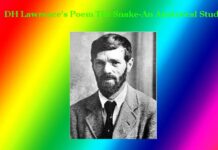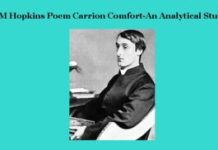Grand Style of John Milton
Grand Style of John Milton
John Milton was a great narrative poet in the English language. In his poetry, he dealt with sublime themes such as –vice, virtue, love, liberty, power, beauty, humanity etc. The characters of his narrative poems were also sublime such as –God, Angels, Satan, Adam, Eve, Prophets, etc. And to fit his sublime (most exalted) themes, Milton used a new bold, grave and mighty style which is called ‘Grand Style’. His grand style is characterized by rich and varied imageries, extended similes and metaphors, wavy blank verse, compressed construction of phrases-clauses, remarkable use of figures of speech, and abundant use of allusion and references. Let us illustrate his grand style as below:
Rich and Varied Imageries
Milton’s imageries are rich and varied. He decorates everything that comes out of his mind with colour, grace, and a mighty body. His imageries are noble and idealized. In making out his imageries he ransacks the entire universe with keen eyes, a sensitive heart, and scholastic knowledge. His imageries are so varied that there are the imageries of light and shadow, of sorrows and pleasure, of vice and virtue, of broadness and narrowness, of beauty and ugliness which are drawn from classical learning as well as contemporary life. In portraying the imageries of Hell and darkness, Milton writes:
‘A dungeon horrible, on all sides round,
As one great furnace flamed: yet from these flames
No light, but rather darkness visible
Served only to discover sights of woe.’
Extended Similes and Metaphors
Milton is a protean master of simile and metaphor. Most of his grand imageries are made of similes and metaphors, but his similes and metaphors are long and vast. In giving the description of Satan’s shield and spear, he writes:
‘His ponderous shield
Ethereal temper, massy, large and round
Behind him cast. The broad circumference
Hung on his shoulders like the moon, whose orb
Through optic glass the Tuscan artist views.’
In drawing similes, Milton was inspired by Homer as his similes extended so long that gave birth to a short descriptive poem.
Use of Wavy Blank Verse
Milton was the first in the English language to use blank verse with great skill in narrative poems. His blank verse is melodious not like lyrics but like the gust of storm wind or like the waves of the sea. The waves are created between clauses and phrases, between ideas and emotions. For instance, we can quote the following lines at random that portrays God’s action against Satan’s foul rebellion:
‘Him the Almighty Power
Hurled headlong flaming from the ethereal down
To bottomless perdition, there to dwell.’
Compressed Construction
Milton’s sentence construction is compressed. He successfully tries to convey more meanings by using one word or phrase. He also crowds his verse with meanings by using Latin and Greek construction. He uses ‘Virtue’ for bravery, and ‘manliness’, ‘puny’ for ‘born later’.
Remarkable Use of Figures of Speech
John Milton, in his poetic works especially in ‘The Paradise Lost’ uses abundant figures of speech, as- periphrasis, rhetorical questions and so on. For an example of Periphrasis, we can quote the following lines:
‘Through optic glass the Tuskan artist views
At evening from the top of Fesole.’
Here he uses the term ‘optic glass’ for telescope, ‘Tuscan artist’ for Galileo.
For Rhetorical Question, the following lines may be quoted:
(a) ‘What thought the fields be lost?
And all is not lost: the unconquerable will.’
(b) ’Whose fountain who shall tell’
Milton’s verse is replete with sonorous alliteration and repetition, as-
(a) Fierce as ten Furies
Shook a dreadful dart.’
(b) With ruin upon ruin, rout on rout
Confusion worse confounded.
(c) unrespited, unpitied, unreprieved.
Abundant Use of Allusions and References
Milton’s poetry is rich in allusions and references from history, legends, classical literature, and other sources. His allusions and references have made his poetry a complex one. They also bear the testimony of how learned he was! At random we can quote-
”Those other two equalled with me in Fate
So were I equalled with them in renown.
Blind Thamyris and Blind Maconides
And Tiresius and Phineus, Prophets old.”
Through the quoted lines, Milton compares his own blindness as well as his own genius with that of ancient Greek poets.
From the above analysis we can arrive at the following conclusions:
First, the above analysis, though brief, shows that Milton’s style was peculiar to his won which were as grand and sublime as his themes are.
Secondly, his style is not simple but complex and so varied that they render difficult to his poetry for the average reader. 0 0 0.
Grand Style of John Milton
You May Like:
Grand Style of John Milton
N. B. The article ‘Grand Style of John Milton’ originally belongs to the book entitled ‘Critical Essays on English Poetry‘ by Menonim Menonimus.
Grand Style of John Milton
Books on Literary Criticism by M. Menonimus:
- World Short Story Criticism
- World Poetry Criticism
- World Drama Criticism
- World Novel Criticism
- World Essay Criticism
- Indian English Poetry Criticism
- Indian English Poets and Poetry Chief Features
- Emily Dickinson’s Poetry-A Thematic Study
- Walt Whitman’s Poetry-A Thematic Study
- Critical Essays on English Poetry
- Tawfiq al-Hakim’s Novel: Return of the Spirit-An Analytical Study
- Tawfiq al-Hakim’s Novel: ‘Yawmiyyat Naib Fil Arayaf’-An Analytical Study
- Analytical Studies of Some Arabic Short Stories
- A Brief History of Arabic Literature: Pre-Islamic Period (500 AD-622 AD)
- A Brief History of Arabic Literature: Early Islamic Period (622 AD-661 AD) …
Related Search:
- Milton’s Grand Style
- Milton’s Grand Style in Paradise Lost
- John Milton Hail Holy Light
- John Milton Hail Holy Light Analysis
- Paradise Lost: Blending of Reformation and Renaissance
- Puritan and Classical Elements in Milton











